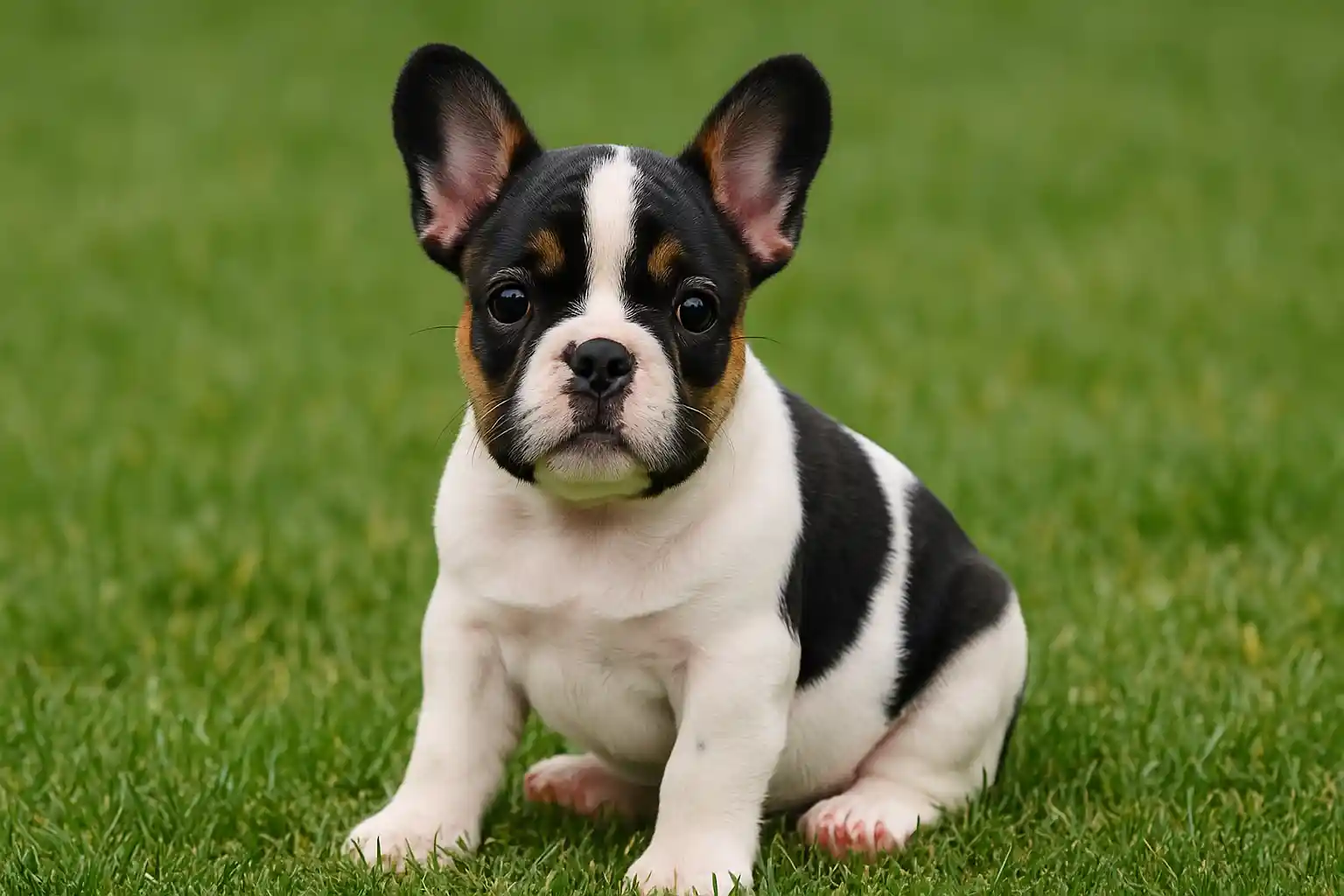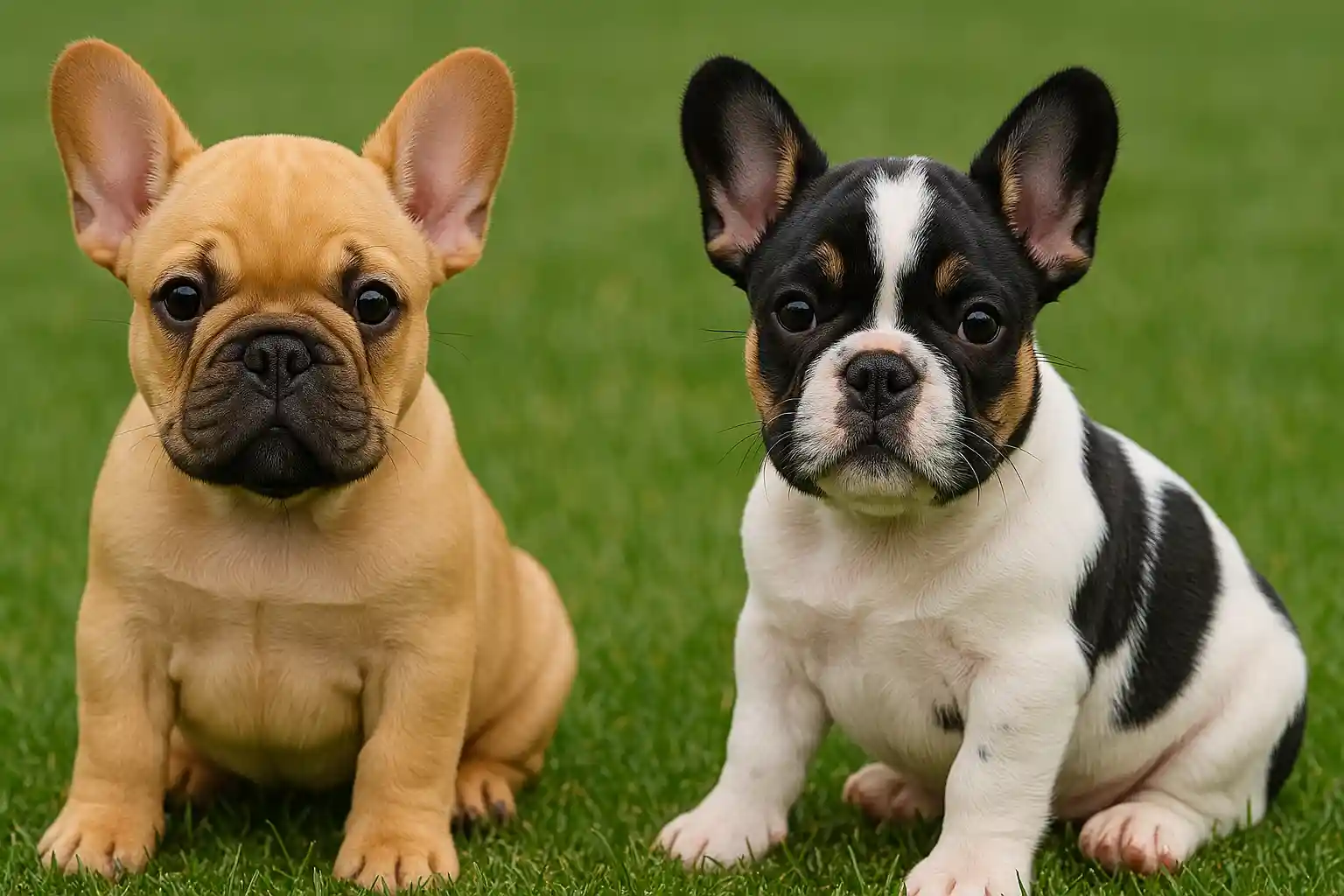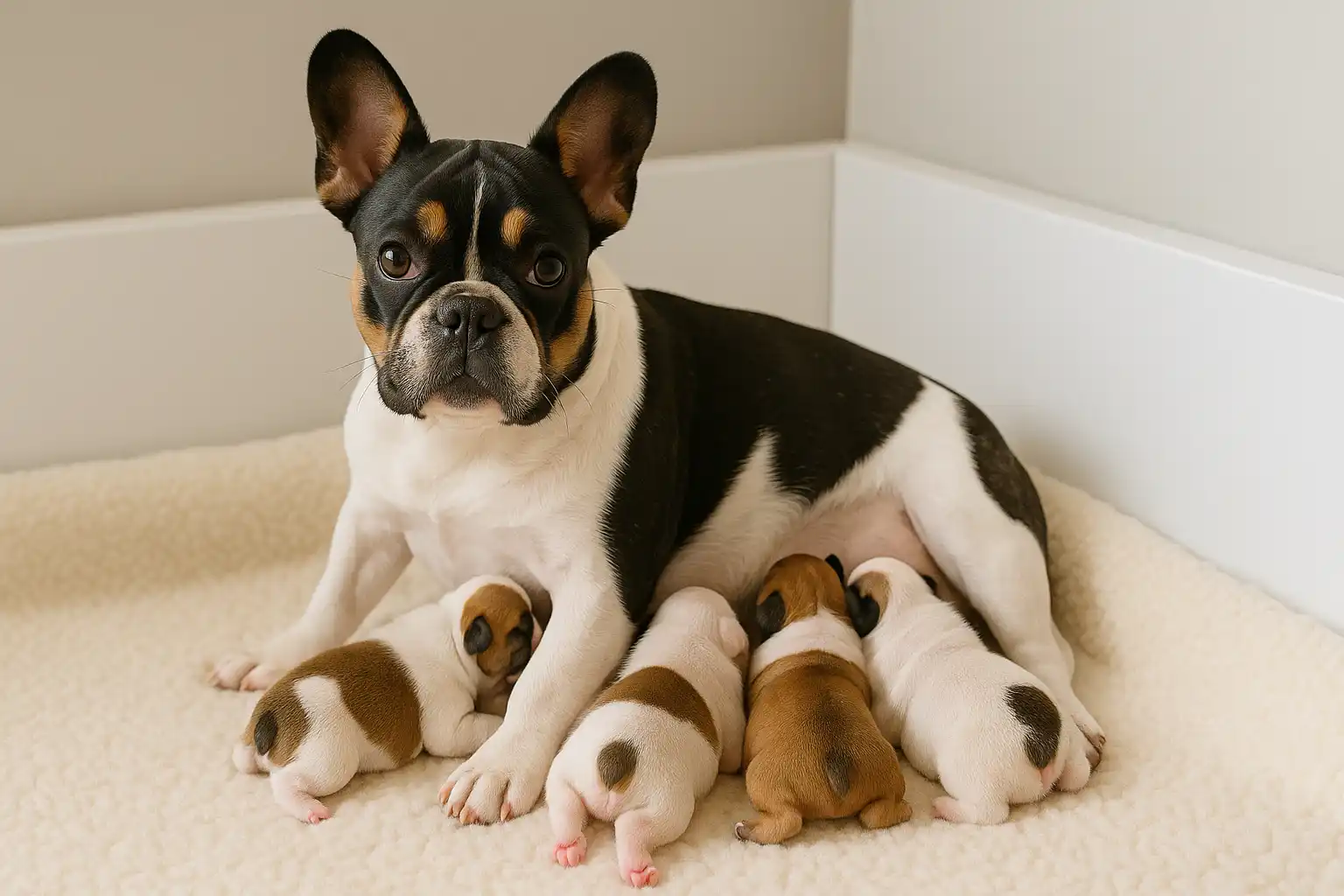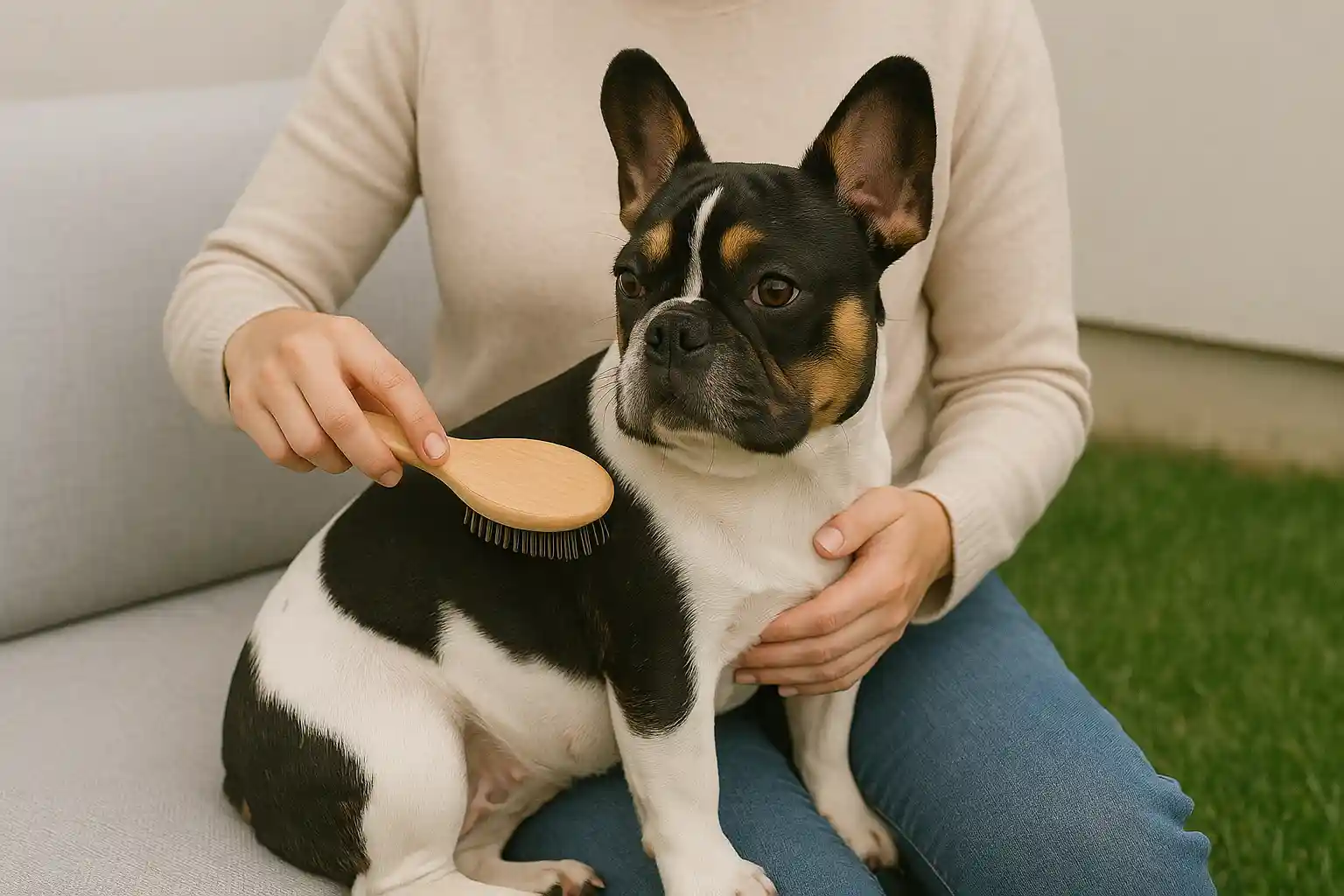Fascinated by the striking French Bulldog tri color patterns? These remarkable tri color French Bulldogs combine distinctive coat patterns with the beloved Frenchie personality, making them among the most sought-after variations of this popular breed.
When I first encountered a tri color French Bulldog at a specialized breed show, I was immediately captivated by its unique coat pattern. These tri color French Bulldogs showcase a stunning combination of three distinct colors that make them some of the most visually striking members of the breed. French Bulldog tri colors have become increasingly sought-after by Frenchie enthusiasts looking for a companion that stands out from the crowd, and it’s easy to see why these distinctive dogs catch everyone’s attention. The French Bulldog tri color variation represents a fascinating example of canine genetics at work, creating these beautiful and distinctive pets.
What is a French Bulldog Tri Color?
A French Bulldog tri color is a specialized variation of the beloved French Bulldog breed that displays three distinct colors in their coat pattern. Unlike standard Frenchies that typically show one or two colors, tri color French Bulldogs exhibit a base color (usually white) with two additional colors distributed throughout their coat. These striking tri color French Bulldogs carry specific genetic markers that produce this unique coloration, setting them apart from other coat variations.
The most recognizable feature of French Bulldog tri colors is their distinctive coat pattern, which often includes patches of color around the eyes (commonly called “pied markings”), on the back, and sometimes on the ears. The tri color French Bulldog pattern typically includes specific placement of tan points—above the eyes, on the cheeks, on the chest, and sometimes on the legs. The genetic combination that produces French Bulldog tri coloration is relatively rare in the breed’s gene pool, making these Frenchies more unusual and highly valued among breed enthusiasts.
From a genetic standpoint, the tri color French Bulldog pattern results from specific genes working in combination. True tri color patterning requires the presence of the tan point gene (at) along with other color genes that determine the base colors. This specific genetic formula is what creates the distinctive three-color appearance that characterizes an authentic French Bulldog tri color.

Characteristics of French Bulldog Tri Color
Tri color French Bulldogs share the same physical structure and temperament as standard Frenchies but with their signature three-color coat pattern. These French Bulldog tri colors typically weigh between 16-28 pounds and stand about 11-12 inches tall at the shoulder. Their compact, muscular build and characteristic “bat ears” remain consistent with breed standards, regardless of their distinctive coloration.
The coat patterns in tri color French Bulldogs can vary significantly, but they always feature three distinct colors, creating the signature French Bulldog tri color appearance. Common combinations include:
- Black tri color French Bulldog: White base with black patches and tan points (most common tri color variation)
- Blue tri color French Bulldog: White base with diluted black (blue/gray) patches and tan points
- Chocolate tri color French Bulldog: White base with brown patches and tan points
- Lilac tri color French Bulldog: White base with diluted chocolate (lilac) patches and tan points
When examining a French Bulldog tri color, you’ll notice the tan points follow a specific pattern. These tan markings typically appear in consistent locations: above the eyes creating “eyebrows,” on the cheeks, inside the ears, on the chest as “buttons,” and sometimes on the lower legs and under the tail. This predictable pattern is a hallmark of the true tri color French Bulldog genetic expression.
Beyond their stunning appearance, tri color French Bulldogs share the same lovable personality traits that make the breed so popular. French Bulldog tri colors are typically affectionate, playful, and make excellent companions for various living situations, from apartments to houses with yards. Their intelligence combined with a sometimes stubborn streak makes these tri color French Bulldogs charming and entertaining companions that form strong bonds with their families.
In my experience with various French Bulldog tri colors, I’ve found their temperament to be consistent with the breed standard—friendly, alert, and adaptable. My tri color Frenchie, Max, displays the same characteristic “clown-like” personality that French Bulldogs are famous for, regardless of his distinctive coat coloration.
Differences Between Tri Color and Standard French Bulldogs
The primary difference between tri color French Bulldogs and standard French Bulldogs lies in their coat coloration. Standard French Bulldogs typically come in solid colors like fawn, cream, or brindle, while French Bulldog tri colors showcase three distinct colors in specific patterns that create their eye-catching appearance. Understanding these differences is important for prospective owners interested in the unique French Bulldog tri color variation.
From a genetic standpoint, tri color French Bulldogs carry specific color genes that standard Frenchies don’t have. The French Bulldog tri color pattern comes from the presence of the tan point gene (at) along with other color genes, creating the distinctive three-color appearance. This genetic combination is what produces the signature tri color French Bulldog coat pattern that enthusiasts prize so highly.
The base genetics for a tri color French Bulldog include:
- The tan point gene: Controls the placement of tan markings
- A color gene: Determines the primary color (black, blue, chocolate, or lilac)
- Pattern genes: Influence how colors are distributed (often including white spotting)
When examining French Bulldog tri colors versus standard colors, the most obvious visual difference is the presence of tan points. In a tri color French Bulldog, these tan markings appear in predictable locations—above the eyes, on the cheeks, inside the ears, on the chest, and sometimes on the lower legs. Standard French Bulldogs lack these distinct tan point markers.
It’s important to note that despite these color differences, tri color French Bulldogs are not a separate breed. They are purebred French Bulldogs with a specific color variation. A tri color French Bulldog’s health needs, temperament, and care requirements remain consistent with the breed standard. Their distinctive appearance doesn’t change the fact that they are, in all essential aspects, true French Bulldogs with the same charming characteristics that make the breed so beloved.
From a recognition standpoint, the acceptance of French Bulldog tri colors varies among kennel clubs. While all tri color French Bulldogs can be registered with major kennel clubs as purebred French Bulldogs, some color patterns might not be eligible for showing in conformation events, as they fall outside the standard color specifications for the breed. This distinction affects show eligibility but not the quality or purebred status of these tri color French Bulldogs.

Popular Color Combinations in Tri Color French Bulldogs
Among tri color French Bulldogs, certain color combinations tend to be more common or sought-after by enthusiasts. These unique French Bulldog tri color variations each have distinctive characteristics that make them special. Understanding the different tri color French Bulldog variations helps prospective owners identify their preferred color combination.
Black Tri Color French Bulldog
The black tri color French Bulldog features a primarily white base coat with black patches and tan points (typically appearing above the eyes, on the cheeks, inside the ears, on the chest, and on the legs). This is the most common and recognizable tri color French Bulldog pattern. In these dogs, the black coloration is produced by the dominant black gene (B), while the tan points are controlled by the tan point gene (at). Black tri color French Bulldogs often have striking contrast between their colors, making their markings particularly vivid and eye-catching.
Blue Tri Color French Bulldog
Blue tri color French Bulldogs have a diluted black color (appearing bluish-gray) instead of pure black, combined with white and tan markings. This beautiful French Bulldog tri color variation comes from the dilution gene (d) affecting the black color. The blue coloration creates a softer, more subtle appearance compared to the high contrast of black tri colors. Blue tri color French Bulldogs often have grayish-blue nose leather and paw pads to match their coat color, and sometimes their eyes may have a lighter, almost grayish appearance. This French Bulldog tri color variation commands a premium price due to its relative rarity.
Chocolate Tri Color French Bulldog
Chocolate tri color French Bulldogs feature a rich brown color instead of black, combined with white and tan points. This warm-toned French Bulldog tri color results from the recessive brown gene (b) replacing the dominant black gene. Chocolate tri color French Bulldogs typically have brown nose leather and paw pads, and sometimes lighter-colored eyes that complement their rich brown markings. The chocolate coloration creates a warmer, more subdued look compared to the boldness of black tri color French Bulldogs.
Lilac Tri Color French Bulldog
Among the rarest and most sought-after French Bulldog tri color combinations, lilac tri colors display a diluted chocolate color (appearing as a pale grayish-brown or “lilac”), combined with white and tan markings. This exceptionally rare French Bulldog tri color variation requires two sets of recessive genes—both the chocolate gene (b) and the dilution gene (d)—making it genetically the most uncommon of the standard tri colors. Lilac tri color French Bulldogs often have distinctive light-colored eyes and pink-tinted nose leather. The soft, pastel-like appearance of the lilac color gives these French Bulldog tri colors an almost ethereal quality that many enthusiasts find particularly appealing.
Exotic Tri Color Variations
Beyond the standard tri color combinations, some breeders produce more exotic French Bulldog tri color variations by introducing other rare color genes. These can include:
- Merle tri color French Bulldog: Combining the merle pattern gene with tri color
- Platinum tri color French Bulldog: An extremely light variation of the blue tri color
- Sable tri color French Bulldog: Featuring sable patterning with tri coloration
It’s worth noting that some of these more exotic French Bulldog tri color variations may come with additional health considerations, as certain color genes (particularly merle) can sometimes be associated with health issues when not bred responsibly. When seeking a rare French Bulldog tri color, it’s especially important to work with knowledgeable, ethical breeders who prioritize health testing.
All these French Bulldog tri color variations showcase the fascinating genetics at work in the breed, creating a spectacular array of color combinations that continue to captivate Frenchie enthusiasts around the world.
Health Considerations for Tri Color French Bulldogs
Like all French Bulldogs, tri color French Bulldogs are prone to certain health issues that potential owners should be aware of. The tri color French Bulldog pattern itself doesn’t generally cause health problems, but some rare color genes that can appear in certain French Bulldog tri color variations might be linked to health concerns, making responsible breeding practices especially important.
Common Health Issues in French Bulldog Tri Colors
French Bulldog tri colors face the same breed-specific health challenges as standard-colored Frenchies. The most significant health concerns for all French Bulldogs, including tri color variations, include:
- Brachycephalic Airway Syndrome: This condition affects all French Bulldogs, including tri color French Bulldogs, due to their characteristic flat faces. It can cause breathing difficulties, especially during exercise or in hot weather. Symptoms include noisy breathing, snoring, exercise intolerance, and in severe cases, collapse. Owners of French Bulldog tri colors need to be vigilant about monitoring their dog’s breathing, especially during physical activity or in warm temperatures.
- Hip and Spine Issues: French Bulldog tri colors can be prone to hip dysplasia and various spinal disorders, including intervertebral disc disease (IVDD). Their unique body structure with wide shoulders and narrow hips predisposes them to these issues. Signs include difficulty rising, reluctance to jump or use stairs, and in severe cases, pain or paralysis.
- Eye Problems: Various eye conditions can affect French Bulldog tri colors, including cherry eye (prolapse of the third eyelid), entropion (inward rolling of the eyelid), cataracts, and corneal ulcers. Regular eye examinations are important for all French Bulldogs regardless of color.
- Allergies and Skin Conditions: French Bulldogs, including tri color variations, commonly suffer from allergies and various skin conditions. Their facial wrinkles require regular cleaning to prevent skin fold dermatitis, a condition where bacteria and yeast grow in the moist, warm environment created by the skin folds.
- Heat Sensitivity: Due to their brachycephalic nature, all French Bulldogs, including tri color French Bulldogs, are sensitive to heat. They cannot efficiently cool themselves through panting like many other breeds, making them susceptible to overheating and heat stroke. This requires special care during warm weather.
Color-Specific Health Considerations
While the standard tri color pattern (black, white, and tan) doesn’t carry specific health concerns, some rare color variations might have health implications:
- Blue and Lilac Tri Colors: These French Bulldog tri color variations carry the dilution gene, which in some cases has been associated with a condition called Color Dilution Alopecia (CDA). This skin condition can cause hair loss, dry skin, and susceptibility to skin infections. Not all blue or lilac tri color French Bulldogs develop this condition, but it’s something potential owners should be aware of.
- Merle Tri Colors: Merle tri color French Bulldogs (those combining the merle pattern gene with tri color) require special consideration. The merle gene can be associated with auditory and vision issues, especially when two merle-carrying dogs are bred together (resulting in “double merle” puppies). Responsible breeders never breed two merle-carrying dogs together for this reason.
Choosing a Healthy Tri Color French Bulldog
When I adopted my tri color French Bulldog, Milo, I made sure to find a reputable breeder who performed comprehensive health testing on the parent dogs. This step is crucial for any potential French Bulldog owner, but particularly important when seeking rarer color varieties like tri color French Bulldogs, as some unethical breeders may prioritize unusual colors over health and temperament.
Health tests that responsible breeders should conduct on French Bulldogs used for breeding include:
- Hip evaluations to check for hip dysplasia
- Patella examinations to rule out luxating patellas (slipping kneecaps)
- Cardiac exams to check for heart conditions
- Ophthalmologist evaluations to rule out hereditary eye conditions
- DNA tests for genetic conditions common in the breed
A reputable French Bulldog tri color breeder will provide health clearances for both parent dogs and offer a health guarantee for their puppies. They will also be transparent about any potential health concerns specific to their lines and be willing to discuss how they’re working to improve the breed’s health through careful breeding practices.
By prioritizing health over color, you’ll increase your chances of sharing many happy, healthy years with your tri color French Bulldog companion.

Cost of Purchasing a Tri Color French Bulldog
Tri color French Bulldogs typically command significantly higher prices than standard colored Frenchies due to their rarity and high demand. The distinctive appearance of French Bulldog tri colors makes them particularly desirable, creating a premium market for these uniquely patterned dogs.
Price Range for Tri Color French Bulldogs
While standard French Bulldogs generally cost between $1,500 and $3,000, tri color French Bulldogs can range from $4,000 to $10,000 or even more for particularly rare patterns or exceptional bloodlines. This substantial price difference reflects both the genetic rarity of the tri color French Bulldog pattern and the specialized breeding knowledge required to produce these dogs consistently.
The specific cost of a tri color French Bulldog varies based on several key factors:
- Specific tri color combination: Black tri color French Bulldogs, being the most common variation, typically cost less than rarer combinations like blue tri, chocolate tri, or the especially rare lilac tri color French Bulldogs. A lilac tri color French Bulldog from a reputable breeder can sometimes command prices upwards of $15,000 due to the rarity of the color genes required.
- Bloodline and pedigree: French Bulldog tri colors from championship lines or with impressive pedigrees will cost substantially more than those without notable ancestry. Dogs with show-quality structure (regardless of whether the color is showable) also command higher prices.
- Breeder reputation and location: Well-established breeders with strong reputations for producing healthy, well-socialized tri color French Bulldogs typically charge more than less-established breeders. Additionally, prices vary by geographic location, with tri color French Bulldogs typically costing more in major metropolitan areas.
- Gender: Female tri color French Bulldogs often cost 15-30% more than males, as they have breeding potential and are sometimes produced in smaller numbers.
- Quality classification: Breeders typically classify puppies as “pet quality,” “breeding quality,” or “show quality” (though many tri colors don’t meet color standards for showing). Each step up in classification substantially increases the price of a tri color French Bulldog.
Additional Costs of Tri Color French Bulldog Ownership
The purchase price is just the beginning of the financial commitment when acquiring a tri color French Bulldog. Prospective owners should budget for significant ongoing costs:
- Veterinary care: All French Bulldogs, including tri colors, are prone to various health issues that may require specialized veterinary care. Annual wellness visits, vaccinations, preventative medications, and emergency care can add up to $1,000-$2,000 per year for a healthy dog, and potentially much more if health issues develop.
- Health insurance: Due to the breed’s predisposition to certain health conditions, many tri color French Bulldog owners opt for pet insurance, which typically costs $50-$100 per month depending on coverage levels.
- Quality nutrition: Premium dog food tailored to the needs of brachycephalic breeds costs approximately $60-$100 per month for an adult French Bulldog.
- Grooming and hygiene: Professional grooming services (typically every 6-8 weeks) plus at-home supplies for maintaining facial wrinkles and coat health can cost $500-$800 annually.
- Environmental accommodation: Many tri color French Bulldog owners invest in items like air conditioning, special beds, ramps (to prevent jumping), and appropriate harnesses (instead of collars) to accommodate their dog’s specific structural needs, representing another significant investment.
This significant financial commitment makes tri color French Bulldogs one of the more expensive dog varieties to both purchase and maintain. During my search for a tri color French Bulldog, I found that prices varied by as much as $6,000 for puppies that appeared similar, highlighting the importance of understanding what factors influence pricing and what value you’re receiving for your investment.
When considering purchasing a tri color French Bulldog, it’s crucial to avoid “bargain” prices that seem too good to be true—they often indicate corners being cut on health testing, proper care, or even the legitimacy of the breeder. A responsibly-bred tri color French Bulldog represents a significant financial investment, but for many owners, the unique joy of owning these distinctive dogs is well worth the cost.
Where to Find Tri Color French Bulldogs for Adoption
Finding a tri color French Bulldog requires research and patience. The unique nature of French Bulldog tri colors makes them harder to locate than standard varieties. Here are the best places to look for your perfect tri color companion:
Reputable Breeders
The most common source for tri color French Bulldogs is established, ethical breeders who specialize in rare colors. Look for breeders who:
- Perform health testing on parent dogs
- Provide clean, spacious environments for their animals
- Allow visits to see the puppies and their parents
- Offer health guarantees and ongoing support
Rescue Organizations
While less common, tri color French Bulldogs occasionally appear in rescue organizations specializing in brachycephalic breeds or French Bulldogs specifically. Organizations like French Bulldog Rescue Network or local Frenchie rescues may have tri colors available for adoption.
Breed-Specific Online Platforms
Websites dedicated to French Bulldog adoption can be valuable resources. Just be careful to verify the legitimacy of any listing and avoid situations that seem questionable or too good to be true.
When I was searching for my tri color Frenchie, I spent six months on waiting lists with reputable breeders before finding the right match. This patience was well worth it for a healthy, well-socialized puppy.
Breeding Practices for Tri Color French Bulldogs
The genetics behind tri color French Bulldogs are complex and require careful breeding practices. Responsible breeding is essential to maintain the health and wellbeing of these dogs while achieving the desired color patterns.
Ethical breeders focus on:
- Health testing for common French Bulldog issues
- Understanding color genetics thoroughly
- Maintaining genetic diversity
- Prioritizing health and temperament over rare colors
- Avoiding breeding practices that could lead to health problems
It’s important to note that some countries’ kennel clubs have specific regulations regarding acceptable French Bulldog colors. The American Kennel Club (AKC), for example, recognizes certain colors but not others in their breed standard. This doesn’t mean non-standard colors are unhealthy or problematic—just that they may not be eligible for certain dog shows.

Training Tips for Tri Color French Bulldogs
Tri color French Bulldogs share the same training needs as their standard-colored counterparts. These intelligent but sometimes stubborn French Bulldog tri colors benefit from consistent, positive reinforcement-based training methods that respect their unique personalities.
Key training considerations for tri color French Bulldogs:
- Start socialization early to expose them to different people, animals, and environments
- Keep training sessions short (5-10 minutes) due to their limited attention span
- Use high-value treats and plenty of praise
- Be consistent with commands and expectations
- Avoid harsh corrections which can damage your relationship
- Consider crate training for housebreaking and providing a safe space
When training my tri color Frenchie, I found that patience was essential. Their charming but sometimes strong-willed personality means they respond best to gentle persistence rather than strict discipline.
Grooming Needs of Tri Color French Bulldogs
The grooming requirements for tri color French Bulldogs are relatively straightforward but require attention to certain breed-specific concerns. Proper grooming helps maintain the vibrant appearance of a French Bulldog tri color’s coat and ensures overall health:
Coat Care
Their short coat needs minimal maintenance—weekly brushing with a soft bristle brush or rubber grooming mitt helps remove loose hair and distribute natural oils. Bathing should be done monthly or as needed with a gentle dog shampoo.
Wrinkle Cleaning
The characteristic facial wrinkles of French Bulldogs, including tri colors, need regular cleaning to prevent moisture buildup and potential skin infections. Daily wiping with a damp cloth followed by thorough drying is recommended.
Nail Trimming
Regular nail trims (typically every 3-4 weeks) are important as French Bulldogs don’t naturally wear down their nails through exercise like more active breeds.
Ear Cleaning
Their prominent bat ears should be checked weekly and cleaned as needed to prevent wax buildup and reduce the risk of infections.
Dental Care
Daily tooth brushing or dental chews help maintain oral health and prevent dental disease, which is common in small breed dogs.

Pros and Cons of Owning a Tri Color French Bulldog
Before bringing home a tri color French Bulldog, it’s important to consider both the advantages and challenges of owning these special French Bulldog tri color companions:
Pros:
- Unique, eye-catching appearance
- Affectionate, companion-oriented temperament
- Generally good with children and other pets
- Adaptable to various living environments, including apartments
- Minimal exercise needs compared to many other breeds
- Strong personality and entertaining antics
Cons:
- Higher purchase price than standard French Bulldogs
- Potential health issues related to brachycephalic anatomy
- Heat intolerance requiring careful monitoring in warm weather
- Possible breathing difficulties limiting exercise capacity
- Higher veterinary costs throughout their lifetime
- Potential for skin issues requiring ongoing management
My experience with my tri color Frenchie has been overwhelmingly positive, but I’ve also invested significantly in preventative healthcare and environmental management (including air conditioning during summer months) to keep him comfortable and healthy.
Frequently Asked Questions About Tri Color French Bulldogs
What is a tri color Frenchie?
A tri color Frenchie is a French Bulldog that displays three distinct colors in its coat pattern. These dogs typically have a white base with two additional colors — most commonly black and tan markings. The tri color pattern results from specific genetic combinations that produce these multiple pigmentations across the dog’s coat.
What is the rarest color of French Bulldog?
The lilac tri color is widely considered the rarest color in French Bulldogs. This striking variation features a diluted chocolate base (appearing as a pale grayish-lavender or “lilac”) combined with white and tan markings. Merle patterns and pure black French Bulldogs with no brindle markings are also extremely rare.
Are tri-color bulldogs rare?
Yes, tri-color French Bulldogs are significantly rarer than standard colors like fawn, cream, or brindle. Their unique genetic makeup requires specific color genes from both parents, making them less common in the general Frenchie population and explaining their premium pricing in the pet market.
What does tri mean in French Bulldogs?
“Tri” in French Bulldogs simply refers to the presence of three distinct colors in the dog’s coat pattern. The most common tri color combination is white, black, and tan, though other variations exist like blue tri (white, blue, and tan) and chocolate tri (white, chocolate, and tan). The term specifically indicates the three-color genetic expression.
Looking for more information about French Bulldogs? Check out our How to Take Care of a French Bulldog for everything you need to know about raising a healthy, happy Frenchie companion, whether you choose a standard or tri color French Bulldog for your family.

